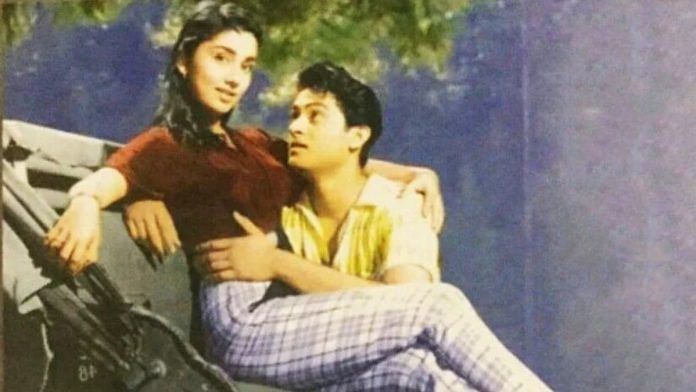RK Nayyar’s Love in Simla gave Bollywood two key things — its first-ever chocolate boy, Joy Mukherjee, and the iconic Sadhana haircut, that is popular even today as ‘bangs’ or ‘fringes’.
The 1960 movie examines the role ‘looks’ play in love, and it follows the classic ugly duckling trope. It also carries subtle messages about self-worth and transformation. The film suggests that true confidence comes not just from one’s beauty but from believing in oneself.
In his debut, Mukherjee starred alongside Sadhana, who was only one film old in the industry at the time. Love in Simla (1960) was Sadhana’s debut as a leading lady. The film begins with the British having left Simla, but their influence can be felt in their absence. The presence of the British is felt through the culture. The high-class get-togethers, the Western dance rooms, and clothes among other things.
It’s the perfect setting for a new elite crowd that frequents clubs and lives in mansions waited on by house staff.
One such mansion belongs to a General (Kishore Sahu), his wife (Shobhana Samarth), and their daughter, Sheela (Azra). Then there is Sonia (Sadhana), the orphaned relative. Sonia isn’t a conventional woman. She wears high-waist pants, shirts, and glasses with thick frames. She soon becomes a target for not being able to catch a man’s attention.
Stung by Sheela’s mocking words, Sonia takes up the challenge and promises to steal Sheela’s fiancé, Dev (Joy Mukherjee).
What follows is a journey of love, self-discovery, and a revenge tale wrapped in a charmingly old-school Bollywood romance.
Sadhana – star of the show
Sadhana is undoubtedly the heart of Love in Simla. Her transformation from a shy, awkward girl to a graceful woman is one of the most enjoyable parts of the film. The new Sonia turns heads, including Dev’s, who begins to see her in a new light.
The Sadhana Cut—the actor’s iconic fringe hairstyle in the film—became a rage among young women in India. Her stylish sarees and dresses also contributed to the fashion trends of that era.
It’s not just about the physical makeover—Sadhana brings quiet confidence to Sonia’s evolution, making her a character worth rooting for.
Even though the ‘ugly duckling’ trope has been used in countless films, Love in Simla presents it in a way that feels endearing rather than superficial. Sonia doesn’t change to impress Dev—she changes for herself, and that’s what makes her transformation satisfying to watch.
Meanwhile, Joy Mukherjee as Dev fits the bill of the classic 1960s romantic hero. He has the looks, the charm, and the ability to pull off the song-and-dance sequences with ease. While his character doesn’t have the most depth, a common feature of male leads in romantic films of that era, he delivers a convincing performance. His chemistry with Sadhana kicks off with banter as he playfully teaches her how to whistle, but later evolves into a breezy, youthful love.
Also read: Sridevi didn’t need VFX for horror. Nagina was a blockbuster
Music overdose
RK Nayyar, who later married Sadhana, directed the film with a light, engaging touch. While the narrative keeps flowing smoothly, ensuring that it never feels stagnant.
The balance between humour and romance is just perfect without becoming overly dramatic.
The screenplay is relatively simple, but it works because of its relatable themes—self-confidence, transformation, and unrequited love turning into mutual affection. The film doesn’t rely on unnecessary twists or over-the-top melodrama, which makes it a comfortable watch even today.
But a Bollywood film from the 1960s is incomplete without an outstanding soundtrack, and Love in Simla delivers on this front. Composed by Iqbal Qureshi, some of the standout tracks include: “Dil Thaam Chale Hum Aaj Kidhar”, “Gaal Gulabi Kisi Ke Hai”, “Yun Zindagi Ke Raste Sanwarte Chale Gaye” and “Haseeno Ki Sawari Hai.”
The lyrics, penned by Rajinder Krishan, are poetic and fit well within the storyline.
That being said, the film features a total of 11 songs, giving it the feel of a musical even for a Bollywood movie. Love in Simla might have worked even better if Nayyar had chosen to trim down some of the tracks.
But for fans of old-school Bollywood romance, this film is a treat.
It has all the elements of a classic—innocent love, light comedy, soulful music, and of course, a stunning makeover sequence that paved the way for many similar films in the future.
(Edited by Ratan Priya)







Please correct the spelling. Simla, not Shimla. Love in Simla
My favourite Sadhana film is Woh Kaun thi. For the songs, led by Lag jaa gale.